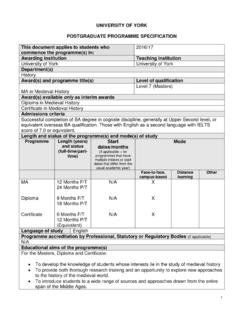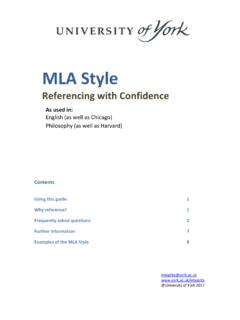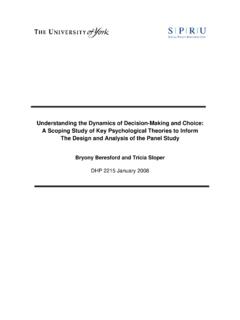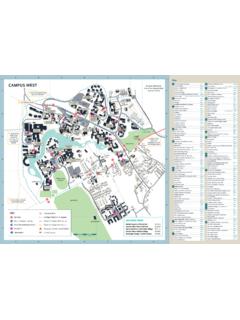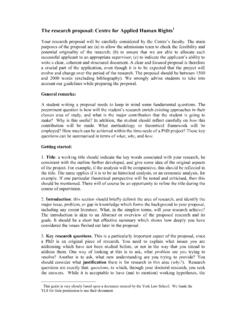Transcription of Chicago Style - University of York
1 Contents Using this guide 1 Why reference? 1 Frequently asked questions 2 Further information 10 Examples of the Chicago Style 10 @ University of York 2017 Chicago Style Referencing with Confidence As used in: English (as well as MLA) History History of Art Referencing with confidence: The Chicago Style 1 Using this Guide This guide is intended to help you understand how to use source material effectively in this referencing Style . It outlines the general features of the Style , but it is important that you follow your department s specific guidelines as there are some different interpretations and requirements that might be specifically required within your discipline. The guide has been compiled using The Chicago Manual of Style (16th ed.), which is the official publication for the referencing Style . You will find more extensive examples of the Chicago Style on the University website at The University also has access to the full Why Reference?
2 Citing and referencing source material is a crucial aspect of academic writing. You will probably be aware that plagiarism (using someone else s work as though it were your own) is a serious form of academic misconduct and it must be avoided at all costs. Referencing accurately and consistently is an important part of ensuring the distinction is clear between your words and the words and ideas of others in your assignments. In-text citation is included in the body of your text and is there to directly show the reader where an idea, piece of information, and/ or a quotation are from. The reader will then be able to match the source cited in the text to the full reference given in your works cited/ bibliography where full details of the publication are presented. Citing of source materials within your assignment is useful and beneficial to supporting your argument. However, be selective. Do not just use as many references as you can in a bid to impress the marker that you ve read a massive amount.
3 Your references should be relevant and integral to your argument, that is, you discuss or critique them in your writing. For example, if you: Include data from your reading (eg tables, statistics, diagrams) Describe or discuss a theory, model or practice from a particular writer Want to add credibility to your argument by bringing in the ideas of another writer for or against Provide quotations or definitions in your essay; Paraphrase or summarise information which is not common knowledge cite the source Referencing with confidence: The Chicago Style 2 2 Frequently asked questions What is the Chicago Style ? The Chicago Style originates from the University of Chicago and is a standard for acknowledging source materials and producing publications. It is used internationally in humanities subjects and provides the scope to cite a wide range of source materials. Chicago is a standard a set format for citing sources using footnotes.
4 When a source is used, a superscript number is given after it to a footnote containing publication details. A bibliography/ reference list of full publication details is then given at the end, with sources listed in alphabetical order by author s last name. The first line of the footnote should be indented, whereas the second and subsequent lines of the reference should be indented. How do I include in-text citations? The Chicago Style of footnotes provides either full details of a source in a footnote or sufficient summary details to allow the reader to identify the source in the reference list/ bibliography. The amount of information provided in footnotes can vary. Full details of a source should be provided the first time a source is cited, with a shortened version for subsequent uses, and then a full reference provided in the reference list/ bibliography. It is important to note that the format of footnotes is slightly different to the format of the reference entry.
5 For example: Hall presents the awkwardness of conversations between a patient and First footnote 1. M. R. Hall, The Coroner (Basingstoke: Pan Books, 2009), 7-10. Subsequent footnote 2. Hall, The Coroner, 12. Reference Hall, M. R. The Coroner. Basingstoke: Pan Books, 2009. In this example, the first footnote provides the details of the publication, giving the author s initials (or first name if listed) first and then last name. 7-10 notes the pages to which the citation refers. The subsequent citation need only give the author s last name and the title, again with the page. Where the title is less than five words, it should not be shortened. Longer titles can be shortened (for example, Larsson s The Girl with the Dragon Tattoo could be shortened to Larsson, Dragon Tattoo ). The reference entry inverts the name, giving the last name before initials/ first name. The title is always given in full in the reference entry.
6 Referencing with confidence: The Chicago Style 3 Is it acceptable to use Ibid. in footnotes? Ibid. , short for Ibidem, meaning in the same place is used in the Chicago Style in certain circumstances where a source is cited on more than one occasion, in place of a shortened version of a source s details. Ibid. should only be used to refer again to the source directly preceding the footnote. The word is used in place of all material on the source that is exactly identical. For example: 3. Emma Smith and Anne Jones. Surrealist Artists (London: Easel Books, 2007), 15. 4. Ibid., 17-18. Ibid. should not be overused and so attention should be paid to how source material is included in the text and footnotes to ensure it remains clear to the reader what material is being cited. How do I effectively cite quotations? Quotations of word-for-word copies of another person s work included in your writing must be clearly distinguished from your own words and ideas.
7 To present quotations in your writing you should either: Run-in the quotation that is include it as part of your sentence OR Format as an indented block quotation When you run-in or indent a quotation depends on the length of the quote: Run-in quotations of less than three lines of text or two lines of poetry. Indent quotations of more than three lines of text or two lines of poetry. Example of a short quotation of text When inserting quotations into your work, use a brief phrase to introduce it. Short quotations should be enclosed within double quotation marks . Give the page number for a quotation within the footnote, but do not include it in the reference list/ bibliography entry, for example: As Neville states, you should cite all sources and present full details of these in your list of references. 5 Footnote: 5. Colin Neville, The Complete Guide to Referencing and Avoiding Plagiarism, 2nd ed.
8 (Maidenhead: Open University Press), 37. Example of a short quotation of poetry Give the line number(s) for lines of poetry or a play script, for example: Coward creates a delicate image of nature in To a Maidenhair Fern , which begins You pretty thing / each dainty frond unbending, 6 Referencing with confidence: The Chicago Style 4 4 Footnote 6. Noel Coward, To a Maidenhair Fern, in The Complete Verse of No l Coward, ed. Barry Day (London: Methuen Drama, 2011), 72, lines 1-2. Reference Coward, Noel. To a Maidenhair Fern. In The Complete Verse of No l Coward, edited by. Barry Day, 72. London: Methuen Drama, 2011. NB: In the Coward example, the name of the poem is given in quotation marks, as it is the title of a poem within a collected edition. The page on which the poem appears in the edited collection is also given, followed by the line numbers of the quoted poem. Note also, in the reference, the page number is moved before the publisher details, and ed.
9 Is replaced by edited by . Example of a longer quotation of text For longer quotations, use block quotation, without quotation marks, but clearly indent the quote to indicate these words are not your own. For example: Neville comments that: It can sometimes be difficult, if not impossible, to avoid using some of the author s original words, particularly those that describe or label phenomena. However, you need to avoid copying out what the author said, word for word. Choose words that you feel give a true impression of the author s original ideas or Footnote 7. Neville, Complete Guide, 38. NB: As the source has been cited previously, a shortened version of the footnote can be used. For poetry, either indent the full quotation and left align, or if appropriate, retain the unusual spacing. For example: Coward creates an optimistic image of nature in To a Maidenhair Fern : You pretty thing, Each dainty frond unbending, Supple unending, Like pearls on a string Your message in sending A promise of 1 Coward, To a Maidenhair Fern , 72, lines 1-6 Referencing with confidence: The Chicago Style 5 When must I use page/ line numbers in my in-text citations?
10 It is important to give a page number in an intext citation in the following circumstances: when quoting directly when referring to a specific detail in a text (for example, a specific theory or idea, an illustration, a table, a set of statistics) when giving a paraphrase or summary from a text. This might mean giving an individual page number or a small range of pages from which you have taken the information. Giving page numbers enables the reader to locate the specific item to which you refer. NB: Where no page or paragraph number can be given for a source, such as an online publication, can be used to denote no pagination . What if I want to reference a work in an in-text citation that has more than one author? If a book or journal has one, two or three authors you should give all three names within your footnote and name all the authors in your reference list/ bibliography. For example: Footnote 9.

